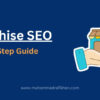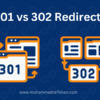# | A | B | C | D | E | F | G | H | I | K | L | M | N | O | P | Q | R | S | T | U | V | W | X |
#
301 Redirect: A permanent redirect that sends website visitors and search engines from one URL to another.
302 Redirect: A temporary redirect that temporarily sends website visitors and search engines from one URL to another.
404 Error: An error message displayed when a webpage cannot be found on a website.
Anchor Text: The clickable text in a hyperlink that provides a description or context for the linked page.
A
Alt Text: Text description added to an image on a webpage, which helps search engines understand the content of the image.
Article Spinning: A technique used to generate multiple versions of an article by automatically replacing words or phrases, often resulting in low-quality and duplicated content.
Auto-generated content: Content created by automated software or bots, typically of low quality and not useful to users.
Authority: The perceived expertise, trustworthiness, and credibility of a website or domain in the eyes of search engines.
Average Position: The average ranking position of a webpage in search engine results pages (SERPs) for a specific keyword or query.
B
Bots: Automated software programs, also known as spiders or crawlers, used by search engines to discover and index webpages.
Backlinks: Links from external websites pointing to a specific webpage, which can contribute to its authority and ranking in search engines.
Black Hat SEO: Unethical and manipulative practices aimed at improving search engine rankings, violating search engine guidelines.
Bounce Rate: The percentage of website visitors who leave a webpage without interacting with it or navigating to other pages.
Broken Link: A hyperlink that leads to a webpage or resource that no longer exists or cannot be accessed.
Branded Keywords: Keywords that include a brand name or variations of it, often used by users searching for a specific brand or its products/services.
C
Cache: A temporary storage location where website data is stored to improve loading speed and reduce server load.
Canonical tag: An HTML tag used to specify the preferred version of a webpage when there are duplicate or similar versions.
Canonical URL: The preferred and canonical version of a webpage that search engines should index and display in search results.
Core Web Vitals: Essential performance metrics used by Google to evaluate and measure user experience on webpages, including loading speed, interactivity, and visual stability.
Crawl Budget: The number of webpages search engine crawlers are willing to crawl on a website within a given time frame.
Crawler: A software program used by search engines to systematically browse and discover webpages on the internet.
Cloaking: Cloaking is a deceptive technique that presents different content to search engines and users, violating search engine guidelines.
D
Disavow: A process of informing search engines to ignore certain backlinks pointing to a website to avoid negative impact on rankings.
Dofollow Link: A hyperlink that allows search engines to follow and pass authority to the linked webpage.
Domain rating (DR): A metric that measures the authority and strength of a domain based on the quantity and quality of its backlinks.
Dynamic URL: A URL that is generated dynamically by a website’s server based on user inputs or other parameters, often containing query strings.
E
E-E-A-T : Stands for Experience, Expertise, Authoritativeness, and Trustworthiness. Google uses these quality criteria to evaluate the credibility and relevance of web pages and websites.
Email Outreach: The practice of reaching out to individuals or websites via email to build relationships, request backlinks, or promote content.
Evergreen Content: Content that remains relevant and valuable over a long period, not tied to specific trends or time-sensitive information.
External Link: A hyperlink that points to a webpage on a different domain or website.
F
Forum backlinks: Backlinks obtained from online forums or discussion boards, often through forum signature links or user-generated content.
G
Google Algorithm: A complex set of rules and calculations used by Google to determine the ranking of webpages in search results.
Google Analytics: A web analytics service provided by Google that tracks and reports website traffic and user behavior.
Google Business Profile: A free business listing on Google, displaying information about a company, such as address, phone number, and reviews.
Google Hummingbird: A major update to the Google search algorithm in 2013, focusing on understanding search queries and user intent more accurately.
Google Knowledge Panel: A prominent information box displayed in search results, providing concise details about a specific entity, person, or organization.
Google Penalty: A negative impact on a website’s rankings and visibility in search results due to violating Google’s guidelines.
Google Search Console: A free web service provided by Google that helps website owners monitor and optimize their site’s presence in Google search results.
Grey Hat SEO: SEO practices that are neither strictly ethical (white hat) nor explicitly unethical (black hat).
Guest Blogging: Writing and publishing articles on other websites as a guest author to gain exposure, backlinks, and authority.
H
Heading Tags: HTML tags (e.g., H1, H2, H3) used to structure and organize headings and subheadings within a webpage’s content.
Hreflang Tag: An HTML attribute used to indicate the language and geographical targeting of a webpage for multilingual and international websites.
HTML Sitemap: A webpage that lists and provides links to all the important pages on a website, designed for user navigation and search engine crawling.
HTTPS: Hypertext Transfer Protocol Secure, an encrypted and secure version of HTTP that ensures secure communication between a website and users.
I
Inbound Link: A hyperlink on an external website that points to a specific webpage on another domain.
Indexability: The ability of a webpage to be discovered, crawled, and included in a search engine’s index for retrieval in search results.
Internal Link: A hyperlink that connects one page to another within the same website/domain.
K
Keyword Cannibalization: A situation where multiple pages on a website target the same or similar keywords, leading to competition and dilution of rankings.
Keyword Clustering: Organizing and grouping related keywords together to create a more organized and focused content strategy.
Keyword Density: The percentage of times a specific keyword appears in a piece of content in relation to the total word count.
Keyword Difficulty: A metric that estimates the level of competition for ranking on search engine results pages for a specific keyword.
Keyword Ranking: The position of a webpage in search engine results for a specific keyword or query.
Keyword Stuffing: Unnatural and excessive repetition of keywords in a webpage’s content, aimed at manipulating search engine rankings.
L
Link Building: Link building is the process of acquiring backlinks from external websites to improve a webpage’s authority, visibility, and search engine rankings.
Link Reclamation: The practice of reclaiming or fixing broken or lost backlinks pointing to a website or specific webpages.
Link Spam: The act of creating low-quality, irrelevant, or manipulative backlinks in an attempt to artificially boost search engine rankings.
Local Citation: A mention or reference of a business’s name, address, and phone number on other websites, directories, or platforms.
Local Pack: A section in Google’s search results that displays a set of local business listings relevant to a specific query.
Local SEO: SEO strategies and techniques focused on improving a website’s visibility and rankings for local searches.
Long-tail Keyword: A longer and more specific keyword phrase that typically has lower search volume but higher conversion potential.
M
Meta Description: An HTML meta tag that provides a brief summary or description of a webpage’s content, displayed in search engine snippets.
Meta Keywords: An HTML meta tag that used to contain a list of keywords relevant to a webpage’s content, but now largely ignored by search engines.
Meta Robots Tag: An HTML meta tag used to instruct search engine crawlers on how to handle indexing and crawling of a webpage.
Meta Tags: HTML tags that provide metadata about a webpage, including information such as title, description, keywords, and character encoding.
N
Natural Link: A backlink that is obtained organically, without any manipulation or intentional efforts to acquire it.
Negative SEO: Unethical tactics employed to harm a competitor’s website’s search engine rankings, such as building spammy backlinks or hacking.
Nofollow: An HTML attribute applied to a hyperlink to tell search engines not to pass authority to the linked webpage.
Noindex Tag: An HTML meta tag used to instruct search engines not to index a particular webpage.
O
Off-page SEO: SEO activities and optimization techniques conducted outside of a website, primarily focused on building backlinks and online reputation.
On-page SEO: On-page SEO activities and optimization techniques performed on a website’s webpages and content to improve search engine rankings.
Open Graph Meta Tags: HTML meta tags used to control how a webpage’s content appears when shared on social media platforms.
Organic Traffic: Website visitors who land on a webpage through unpaid, natural search engine results.
Organic CTR: The percentage of users who click on a specific webpage’s link in search results, out of the total number of impressions it receives.
Orphan Page: A webpage on a website that is not linked to from any other pages, making it difficult for search engines to discover and index.
Outbound Link: A hyperlink on a webpage that leads to another website/domain.
P
Page Speed: The time it takes for a webpage to fully load and display its content to users, an important factor in user experience and search rankings.
PageRank: A proprietary algorithm developed by Google that measures the importance and authority of webpages based on the quantity and quality of their backlinks.
Primary Keyword: The main target keyword that a webpage or content piece is optimized for.
Q
Query: A term or set of terms used by users in a search engine to find information, products, or services.
R
RankBrain: An artificial intelligence system used by Google to understand and interpret user queries, helping to deliver more relevant search results.
Related Searches: Additional search queries suggested by search engines that are related or similar to the original query.
Rich Snippet: A search result snippet that includes additional information, such as ratings, reviews, images, or other structured data.
Responsive Design: Web design approach that ensures a website’s layout and content adjust and display properly on various devices and screen sizes.
Robots.txt: A text file placed on a website’s server to provide instructions to search engine crawlers on which pages to crawl or exclude.
S
Schema Markup: A structured data vocabulary implemented on a webpage to provide additional context and information to search engines.
SERPs: Search Engine Results Pages, the pages displayed by search engines in response to a user’s query.
Search Intent: The underlying purpose or goal behind a user’s search query, such as informational, navigational, transactional, or commercial intent.
Search Volume: The number of times a specific keyword or query is searched for within a given period, indicating its popularity or demand.
Secondary Keywords: Additional relevant words or phrases used in SEO to support and complement primary keywords.
SEO Audit: A comprehensive evaluation of a website’s SEO performance, identifying areas for improvement and optimization.
Short-tail Keywords: Concise and broad search terms consisting of one to three words, often used to target high search volume but competitive queries.
Sitemaps: A file or page that lists all the URLs of a website, helping search engines navigate and index the site’s content effectively.
Sponsored Link Attributes: Tags or markers used to identify paid or sponsored links in order to comply with search engine guidelines and distinguish them from organic search results.
Structured data: Code markup added to web pages that provides context and additional information to search engines, helping them understand the content and display rich snippets in search results.
Subdomain: A subdivision or subsection of a larger domain, typically used to categorize or organize content within a website.
T
Technical SEO: The optimization of a website’s technical aspects and infrastructure to improve its visibility and accessibility to search engines.
Title Tag: An HTML element that specifies the title of a web page, displayed as the clickable headline in search engine results.
Traffic: The number of visitors or users who access a website, measured in terms of the volume and quality of visits.
U
URL Rating (UR): A metric used to measure the overall authority and backlink profile of a specific URL or webpage.
URL slug: The user-friendly and human-readable part of a URL that describes the page’s content, usually consisting of keywords or a concise summary.
V
Voice search: The practice of using voice commands or speech recognition technology to conduct online searches instead of typing, typically done through virtual assistants or voice-activated devices.
W
Website Structure: The organization and hierarchy of a website’s pages and content, including navigation menus, categories, and internal linking.
White-hat SEO: Ethical and legitimate SEO techniques that comply with search engine guidelines, focusing on providing value to users and improving website rankings through organic means.
X
XML sitemap: A file that lists all the URLs of a website in an XML format, primarily created for search engines to easily discover and index the site’s pages.





![DoFollow vs. NoFollow Links: Simple & Easy Guide [2023]](https://muhammadrafikhan.com/wp-content/uploads/2023/09/DoFollow-vs.-NoFollow-Links-Simple-Easy-Guide-2023-100x100.png)



![DoFollow vs. NoFollow Links: Simple & Easy Guide [2023]](https://muhammadrafikhan.com/wp-content/uploads/2023/09/DoFollow-vs.-NoFollow-Links-Simple-Easy-Guide-2023-900x536.png)